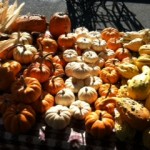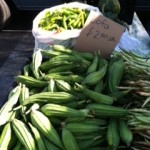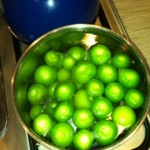The Seattle rain pummeled against tall, gothic-shaped windows as I sat down with a cup of hot coffee and a university-catered croissant, waiting for the conference to begin. I cradled the coffee cup in my hands as I sipped, then bit into the croissant to find it hard, stale and cardboard-like. I flashed back to the croissants I’d eaten in France just two weeks before. Flakey, fresh, and slightly crispy on the outside, buttery and chewy on the inside, French croissants never disappointed us at any time of day, whether they were purchased in Paris, Provence, Brittany or Normandy.
My husband, Ken, and I ate our way through France. From Paris to the Mediterranean coast, to Normandy and Brittany and then back to Paris, our adventurous palettes grew spoiled. “Moules et frites” (mussels and fries) were a popular choice throughout the country, with the most memorable being in Dinan, Brittany, where one menu offered 40 choices of sauces. Ken chose the curry, which exploded in our mouths, with moules so fresh they seemed to melt upon first tasting. That night my choice was pork medallions, which I grilled on a hot stone the waiter brought to our table. A choice of three tangy sauces completed “le plat,” or main course, along with a generous side of mixed vegetables.
Brittany is known for its “galettes,” crepe-like tarts made with buckwheat flour and savory ingredients, and “crepes,” which are made with wheat flour, and filled with sweet delights that tempt you even if like me, you’re not a dessert lover. My long-dormant sweet tooth returned during our three-week sojourn in France and is still with me weeks later.
French cooking can be more meat heavy than we are inclined, so we steered ourselves towards dishes that also included lots of vegetables and/or seafood. In Arles, prawns provençal gave us a preview of what spiciness means in southern France. Dinner at our friends’ table in La Ciotat proved to be some of the best eating ever, with sausage-stuffed peppers, fresh salad and cheeses and salamis from a local farmers’ market—served by Veronique (“Vero) and Olivier. Their neighborhood boulangerie had the freshest “pain au chocolat” ever. I loved exploring the croissant-like bread to find the dark chocolate treasure in the center. Ummm!
Even more remarkable to us was not what the French eat, but how they eat. Meals are never rushed, but are enjoyed and savored. On occasion when we ordered in restaurants, we found ourselves growing impatient with the time it took to receive our meal. We learned how to relax, enjoy our drinks and watch people as we discussed the adventures of our day. Most French restaurants close mid-afternoon and then reopen for dinner at 7 p.m. This threw us at first, but we learned to relax from 5-7 in our room, books in hand.
One day as we strolled along at the harbor in Marseilles, I told Vero that I’d like a cup of coffee to go. “You won’t find that here,” she said. “If you want to drink your coffee quickly, you’ll have to stand at a bar.” Through trial and error I found that she was right—not that I really questioned her, but I needed a coffee fix, which Ken and I found later in a warm, sunny café.
Throughout our trip I surreptitiously read Bringing Up Bebe, by Pamela Druckerman. (After all, I didn’t want the French to think I was studying them!) As an American journalist raising her children in France, Druckerman noticed distinct differences in parenting as well as eating habits. One common practice among the French is to help a new baby adjust to the family’s eating schedule: 8 a.m. (breakfast), noon (lunch), 4 p.m. (snack time for children only) and 8 p.m. (dinner). This usually occurs when the baby is just a few months old. Vero and Olivier and their two young children, ages eight and five years, followed this pattern. After we helped clear the dinner dishes and retired to our room, we could later hear Vero as she tidied the kitchen and prepared for the next morning. This pattern of life seemed a normal, natural rhythm for their family.
My next thoughts, about the many pleasures found in French farmers’ markets, were abruptly interrupted. “Good morning, and thank you for being here,” a male voice boomed. The conference was beginning. I shivered, pulled my down coat around me, turned off my smart phone and prepared to face the day.
~





